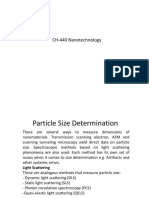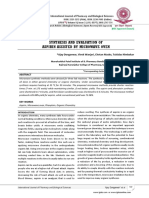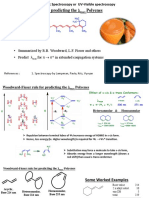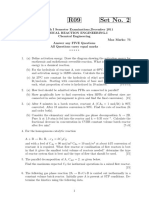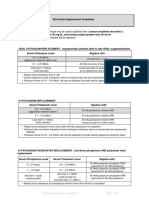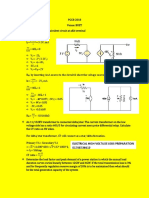0 ratings0% found this document useful (0 votes)
167 viewsCalcite Vs Aragonite
Calcite Vs Aragonite
Uploaded by
wessilissaX-ray diffraction can distinguish between the two calcium carbonate polymorphs, aragonite and calcite, based on their distinct diffraction patterns. However, quantifying mixtures of the two minerals can be challenging due to the robust intensity of calcite's 104 peak. Two alternative approaches are discussed: 1) comparing the integrated areas of calcite 104 and aragonite 221 peaks, and 2) comparing the heights of calcite 113 and aragonite 221 peaks, which have similar intensities in a 50-50 mixture.
Copyright:
© All Rights Reserved
Available Formats
Download as PDF, TXT or read online from Scribd
Calcite Vs Aragonite
Calcite Vs Aragonite
Uploaded by
wessilissa0 ratings0% found this document useful (0 votes)
167 views1 pageX-ray diffraction can distinguish between the two calcium carbonate polymorphs, aragonite and calcite, based on their distinct diffraction patterns. However, quantifying mixtures of the two minerals can be challenging due to the robust intensity of calcite's 104 peak. Two alternative approaches are discussed: 1) comparing the integrated areas of calcite 104 and aragonite 221 peaks, and 2) comparing the heights of calcite 113 and aragonite 221 peaks, which have similar intensities in a 50-50 mixture.
Original Description:
X ray diffraction of Calcite vs Aragonite
Original Title
Calcite vs Aragonite
Copyright
© © All Rights Reserved
Available Formats
PDF, TXT or read online from Scribd
Share this document
Did you find this document useful?
Is this content inappropriate?
X-ray diffraction can distinguish between the two calcium carbonate polymorphs, aragonite and calcite, based on their distinct diffraction patterns. However, quantifying mixtures of the two minerals can be challenging due to the robust intensity of calcite's 104 peak. Two alternative approaches are discussed: 1) comparing the integrated areas of calcite 104 and aragonite 221 peaks, and 2) comparing the heights of calcite 113 and aragonite 221 peaks, which have similar intensities in a 50-50 mixture.
Copyright:
© All Rights Reserved
Available Formats
Download as PDF, TXT or read online from Scribd
Download as pdf or txt
0 ratings0% found this document useful (0 votes)
167 views1 pageCalcite Vs Aragonite
Calcite Vs Aragonite
Uploaded by
wessilissaX-ray diffraction can distinguish between the two calcium carbonate polymorphs, aragonite and calcite, based on their distinct diffraction patterns. However, quantifying mixtures of the two minerals can be challenging due to the robust intensity of calcite's 104 peak. Two alternative approaches are discussed: 1) comparing the integrated areas of calcite 104 and aragonite 221 peaks, and 2) comparing the heights of calcite 113 and aragonite 221 peaks, which have similar intensities in a 50-50 mixture.
Copyright:
© All Rights Reserved
Available Formats
Download as PDF, TXT or read online from Scribd
Download as pdf or txt
You are on page 1of 1
Railsback's Some Fundamentals of Mineralogy and Geochemistry
X-ray diffraction (XRD) of aragonite and calcite
X-ray diffraction provides an easy way Dickinson and McGrath (2001, The Analyst
to distinguish between the two polymorphs 126, 1118–1121) used the ratio of integrated
of CaCO3, aragonite and calcite. The two peak areas (not heights) of the calcite 104
minerals have their highest-intensity peaks and aragonite 221 peaks to develop a quanti-
at different positions, and the general look tative relationship for ratio of aragonite to
of the two patterns is different. Aragonite calcite. That approach yields good quanti-
has its greatest peak (111) at relatively small tative results, if with the somewhat unsettling
°2Θ and has several lesser peaks, whereas proviso that a 50-50 mixture of the two ploy-
calcite has a booming 104 peak a bit to the morphs has a 104/221 intensity ratio much
right of the aragonite large peak, and few greater than 1, because of the exceptional
and comparatively small other peaks. intensity of the calcite 104 peak.
That difference in patterns, if con- Another approach that yields a more
venient for quick identification of a pure intuitively acceptable result is to compare the
sample, makes analysis of mixtures a bit calcite 113 and aragonite 221 peaks. In this
more challenging. The calcite 104 peak is case, an 50-50 equal mixture of calcite and
so robust that it is typically larger than the aragonite generates peaks of about the same
aragonite 111 peak, even in a mixture that height, facilitating a quick-look approach. On
is 75% aragonite. The aragonite peak, in a pattern generated with CoKα radiation, these
contrast, begins to disappear in the noise peaks are at about 46 and 54 °2Θ, and thus
of a calcite XRD pattern if aragonite is less conveniently symmetrically positioned around 50°.
than 25% of the sample. Thus comparison On a pattern generated with CuKα radiation,
of the most intense peaks becomes a
they're at about 40 and 46 °2Θ, not quite so con-
tricky and potentially misleading enterprise.
veniently symmetrically positioned around 43°,
The usual solution to this problem is
but not hard to find.
to use the aragonite 221 peak as an indicator
of the abundance of aragonite. For example,
LBR A&CmixturesXRD01.odg 7/2012
You might also like
- The Solubility Product of PbCl2 From Electrochemical MeasurementsDocument2 pagesThe Solubility Product of PbCl2 From Electrochemical MeasurementsJosé Urpez0% (1)
- KEVA Plank ActivitiesDocument15 pagesKEVA Plank ActivitiesRobert Steven CiaccioNo ratings yet
- Pharmaceutical AnalysisDocument10 pagesPharmaceutical AnalysisAnoosha FarooquiNo ratings yet
- Synthesis of AspirinDocument7 pagesSynthesis of AspirinAzubuike WoguNo ratings yet
- Becke Line TestDocument1 pageBecke Line TestwessilissaNo ratings yet
- FOIN C1003 Alginate Calcium WDocument24 pagesFOIN C1003 Alginate Calcium Wsfff88No ratings yet
- CS350 - DATABASE MANAGEMENT SYSTEM 1 - Quiz 2Document5 pagesCS350 - DATABASE MANAGEMENT SYSTEM 1 - Quiz 2jikjikNo ratings yet
- Arkady Plotnitsky Reconfigurations Critical Theory and General EconomyDocument442 pagesArkady Plotnitsky Reconfigurations Critical Theory and General EconomyLeonardo Bahamondes100% (4)
- Answers To Self-Tests and ExercisesDocument50 pagesAnswers To Self-Tests and ExercisesALAN GUONo ratings yet
- A Novel Validated UV Spectroscopy Method For The Determination of Prucalopride Succinate in Solid Dosage FormDocument8 pagesA Novel Validated UV Spectroscopy Method For The Determination of Prucalopride Succinate in Solid Dosage FormInternational Journal of Innovative Science and Research TechnologyNo ratings yet
- Dominikus - Jurnal Reaksi Perisiklik 2Document3 pagesDominikus - Jurnal Reaksi Perisiklik 2Ekin Dwi ArifNo ratings yet
- Molecular Spectroscopy 2022Document120 pagesMolecular Spectroscopy 2022Lesedi mmabatho MashabelaNo ratings yet
- Predictions of Crystal Structure Based On Radius RatioDocument4 pagesPredictions of Crystal Structure Based On Radius Ratioscribd382No ratings yet
- CH-440 NanotechnologyDocument22 pagesCH-440 NanotechnologyAndrew SionNo ratings yet
- International JournalDocument4 pagesInternational JournalBrahma Hakim Yuanda HutabaratNo ratings yet
- Chapter 1Document5 pagesChapter 1Christian EduardoNo ratings yet
- Coordination Chemistry - Raju KagneDocument41 pagesCoordination Chemistry - Raju KagneggwyiwdNo ratings yet
- Tugas 5 - Self Assesment Test: KnownDocument3 pagesTugas 5 - Self Assesment Test: KnownJenny AzzahraNo ratings yet
- Coefficient of Friction of Composite Delamination Surfaces: Joakim SchonDocument13 pagesCoefficient of Friction of Composite Delamination Surfaces: Joakim SchonchawlakomalNo ratings yet
- GDocument3 pagesGGabrielNo ratings yet
- Light Scattering: A Brief IntroductionDocument52 pagesLight Scattering: A Brief IntroductionAbhishek YadavNo ratings yet
- Sintesis Dan Karakterisasi Senyawa Kompleks ZnII-8Document5 pagesSintesis Dan Karakterisasi Senyawa Kompleks ZnII-8Rafika Firda Umamy HatibieNo ratings yet
- Tatanama Senyawa KompleksDocument52 pagesTatanama Senyawa KompleksRomanNo ratings yet
- ch9 AlkynesDocument7 pagesch9 AlkynesApichat JunsodNo ratings yet
- Amperometric TitrationsDocument5 pagesAmperometric Titrationsarun231187100% (1)
- Tabla Periódica PDFDocument1 pageTabla Periódica PDFGladysdelCarmen Moreno RamosNo ratings yet
- Pembuatan Cis Dan Trans Kalium DioksalatodiakuokromatDocument10 pagesPembuatan Cis Dan Trans Kalium DioksalatodiakuokromatZulvana Anggraeni HarvianNo ratings yet
- Trans-Effects in Octahedral Transition Metal Coe2000 PDFDocument76 pagesTrans-Effects in Octahedral Transition Metal Coe2000 PDFFelipe ReisNo ratings yet
- Latihan Soal Adisi, Eliminasi, Penataan UlangDocument16 pagesLatihan Soal Adisi, Eliminasi, Penataan UlangBerlian EnggaraniNo ratings yet
- Ion Kompleks Karbonatotetraaminkobalt (Iii)Document4 pagesIon Kompleks Karbonatotetraaminkobalt (Iii)Rizky NugrohoNo ratings yet
- Preparatory Problems PDFDocument2 pagesPreparatory Problems PDFGerel BayrmagnaiNo ratings yet
- Synthesis Gas Flue Gas: BurnerDocument2 pagesSynthesis Gas Flue Gas: BurnerAbu Bakar Ameer KhanNo ratings yet
- Complexometric Titration 1Document14 pagesComplexometric Titration 1Girma Selale0% (1)
- Laporan Unit 6 Anorganik Mutia SalsabilaDocument47 pagesLaporan Unit 6 Anorganik Mutia SalsabilaMutia SalsabilaNo ratings yet
- Soal - Try Out UAS Fisika KuantumDocument3 pagesSoal - Try Out UAS Fisika KuantumMega LialitaNo ratings yet
- 2,4-Dinitrophenylhydrazine MSDS: Section 1: Chemical Product and Company IdentificationDocument5 pages2,4-Dinitrophenylhydrazine MSDS: Section 1: Chemical Product and Company IdentificationJoeco Abay-abay100% (1)
- Aspirin SynthesisDocument5 pagesAspirin SynthesisJenny MorenoNo ratings yet
- Woodward-Fieser Rule For Predicting The L Polyenes: Electronic Spectroscopy or UV-Visible SpectrosDocument6 pagesWoodward-Fieser Rule For Predicting The L Polyenes: Electronic Spectroscopy or UV-Visible SpectrosAditya TiwariNo ratings yet
- Appendix III D. Liquid Chromatography - British PharmacopoeiaDocument4 pagesAppendix III D. Liquid Chromatography - British PharmacopoeiaAbd El-Rahman Sayed100% (1)
- Spektroskopi Serapan Atom AASDocument65 pagesSpektroskopi Serapan Atom AASAlunaficha Melody KiraniaNo ratings yet
- Uss Dual Nature PDFDocument60 pagesUss Dual Nature PDF100 RishabhNo ratings yet
- 7I - Summary and Problems - Chemwiki PDFDocument9 pages7I - Summary and Problems - Chemwiki PDFdicky saputraNo ratings yet
- Halogenasi KetonDocument62 pagesHalogenasi KetonMurni Purnama SariNo ratings yet
- TR 02Document2 pagesTR 02SuryaNo ratings yet
- Jurnal Bahasa Inggris Tentang Teknik KimiaDocument6 pagesJurnal Bahasa Inggris Tentang Teknik KimiaGalangNo ratings yet
- 2012 Intro OrganologamDocument43 pages2012 Intro OrganologamJodhi Hartono PutraNo ratings yet
- 4f6ddb76-37d3-4a41-b5f1-f0b1ec5ecfa6Document3 pages4f6ddb76-37d3-4a41-b5f1-f0b1ec5ecfa6Kanishka YadavNo ratings yet
- 362 Ps 6 SolnsDocument13 pages362 Ps 6 Solnsrameshaarya99No ratings yet
- Kelarutan Sebagai Fungsi SuhuDocument13 pagesKelarutan Sebagai Fungsi SuhuPentyCahyaArhinnaNo ratings yet
- Kuliah NMR 6Document20 pagesKuliah NMR 6Leni LismayantiNo ratings yet
- Peter Atkins Julio de Paula Ron Friedman Physical Chemistry Quanta (0766-0816)Document51 pagesPeter Atkins Julio de Paula Ron Friedman Physical Chemistry Quanta (0766-0816)Administracion OTIC IVICNo ratings yet
- Konsep Fasa Dan Diagram Kesetimbangan FasaDocument38 pagesKonsep Fasa Dan Diagram Kesetimbangan FasaIdo Widya YudhatamaNo ratings yet
- Molten Salt by HousecroftDocument7 pagesMolten Salt by HousecroftWwJd HeavenNo ratings yet
- Bietanol Kulit Pisang PDFDocument15 pagesBietanol Kulit Pisang PDFRomauli NataliaNo ratings yet
- R09 Set No. 2Document8 pagesR09 Set No. 2Shakoor MalikNo ratings yet
- Jurnal Praktikum Dasar-Dasar Pemisahan Kimia Pembuatan Membran Polysulfon (PSF)Document9 pagesJurnal Praktikum Dasar-Dasar Pemisahan Kimia Pembuatan Membran Polysulfon (PSF)Rizki AuNo ratings yet
- Crystallization and Morphological Characteristics of Acetyl-Salicylic Acid (Aspirin) Synthesized From Substrates of Different SourceDocument17 pagesCrystallization and Morphological Characteristics of Acetyl-Salicylic Acid (Aspirin) Synthesized From Substrates of Different SourceExame2021No ratings yet
- TesDocument6 pagesTesDanika PutriNo ratings yet
- Bahasa Inggris Teknik - Controlling The Plant InstrumentationDocument15 pagesBahasa Inggris Teknik - Controlling The Plant InstrumentationIka Mustika WatiNo ratings yet
- Konduktometri PDFDocument7 pagesKonduktometri PDFYuliaKamilawatiIINo ratings yet
- Daftar PustakaDocument4 pagesDaftar PustakaraninovNo ratings yet
- MT: Diffusion With A Heterogeneous Chemical ReactionDocument11 pagesMT: Diffusion With A Heterogeneous Chemical Reactionquark87No ratings yet
- Ghosh 1999Document8 pagesGhosh 1999rasyarifahNo ratings yet
- K R DatingDocument22 pagesK R DatingMher BuenaflorNo ratings yet
- Geol. 655 Isotope Geochemistry: T K-A - CDocument9 pagesGeol. 655 Isotope Geochemistry: T K-A - CKamal AlmahdyNo ratings yet
- Alphabet AaDocument45 pagesAlphabet AawessilissaNo ratings yet
- TMI Tutorials - Smear Slide Analysis - Getting StartedDocument18 pagesTMI Tutorials - Smear Slide Analysis - Getting StartedwessilissaNo ratings yet
- A Smear Slide Online Reference Tool For Novices and Experts TMI.Document5 pagesA Smear Slide Online Reference Tool For Novices and Experts TMI.wessilissaNo ratings yet
- Ultrasonic Separator - AN ULTRASONIC METHOD FOR ISOLATING NON-CLAY COMPONENTSDocument15 pagesUltrasonic Separator - AN ULTRASONIC METHOD FOR ISOLATING NON-CLAY COMPONENTSwessilissaNo ratings yet
- Foraminifera Key To SpeciesDocument1 pageForaminifera Key To SpecieswessilissaNo ratings yet
- 1.9 Interference FiguresDocument33 pages1.9 Interference FigureswessilissaNo ratings yet
- 64 Albian HMDocument20 pages64 Albian HMwessilissaNo ratings yet
- How To Differentiate Between G. Ruber and G. SacculiferDocument5 pagesHow To Differentiate Between G. Ruber and G. SacculiferwessilissaNo ratings yet
- Barite: Intergrown Tabular Crystals (Rosette) From Morocco. Width of Sample 10 CMDocument3 pagesBarite: Intergrown Tabular Crystals (Rosette) From Morocco. Width of Sample 10 CMwessilissaNo ratings yet
- Atlas of Benthic Shelf Foraminifera of The Southwest AtlanticDocument150 pagesAtlas of Benthic Shelf Foraminifera of The Southwest AtlanticwessilissaNo ratings yet
- Arthur L BloomDocument3 pagesArthur L BloomwessilissaNo ratings yet
- Evolution of Ganges Brahmaputra Western Delta Plain Clues From Sedimentology and Carbon IsotopesDocument18 pagesEvolution of Ganges Brahmaputra Western Delta Plain Clues From Sedimentology and Carbon IsotopeswessilissaNo ratings yet
- Eigenvectors and Eigenvalues: Explained VisuallyDocument9 pagesEigenvectors and Eigenvalues: Explained VisuallywessilissaNo ratings yet
- Dictionary of World Bibliography - C PDFDocument83 pagesDictionary of World Bibliography - C PDFwessilissaNo ratings yet
- What Are Eigenvectors and Eigenvalues - Computer Vision For DummiesDocument16 pagesWhat Are Eigenvectors and Eigenvalues - Computer Vision For DummieswessilissaNo ratings yet
- Determination of Natural Radioactivity and Hazard in Soil Samples in and Around Gold Mining Area in Itagunmodi, South-Western, NigeriaDocument7 pagesDetermination of Natural Radioactivity and Hazard in Soil Samples in and Around Gold Mining Area in Itagunmodi, South-Western, NigeriawessilissaNo ratings yet
- 11 Mineralogy and Sediment ChemistryDocument26 pages11 Mineralogy and Sediment ChemistrywessilissaNo ratings yet
- Sedimentary Pyrite FormationDocument11 pagesSedimentary Pyrite FormationwessilissaNo ratings yet
- Professional Achiever Plus Heavy Duty Power VentDocument2 pagesProfessional Achiever Plus Heavy Duty Power VentjoeNo ratings yet
- Time-Series Analysis and Forecasting: Least Squares MethodDocument17 pagesTime-Series Analysis and Forecasting: Least Squares Methodveer12311No ratings yet
- Table-1:: A. Wind Load Combination ExplanationDocument3 pagesTable-1:: A. Wind Load Combination ExplanationPravin GadlingNo ratings yet
- Matco Malaysia Company ProfileDocument14 pagesMatco Malaysia Company Profilemud33bNo ratings yet
- TS10 - TS3000Document65 pagesTS10 - TS3000Serrefriair Garcia RefriNo ratings yet
- Lex Yacc Program PracticeDocument21 pagesLex Yacc Program PracticeAmisha SharmaNo ratings yet
- PREVENTA Safety Relays Emergency Stop, Limit Switch, Sensor Mat and Edge MonitoringDocument1 pagePREVENTA Safety Relays Emergency Stop, Limit Switch, Sensor Mat and Edge MonitoringIan Bruno Rodriguez CenturionNo ratings yet
- RK College of Engineering: Course HandoutDocument9 pagesRK College of Engineering: Course HandoutHODCSE RKCENo ratings yet
- Iii Ece I SemDocument45 pagesIii Ece I SemMacharla DevikaNo ratings yet
- 12 Pulse ConverterDocument5 pages12 Pulse ConvertersumitchintuNo ratings yet
- Twice-Yearly Lenacapavir or Daily F:TAF For HIV Prevention in Cisgender Women - PubMedDocument1 pageTwice-Yearly Lenacapavir or Daily F:TAF For HIV Prevention in Cisgender Women - PubMedEve BedinNo ratings yet
- Grade 10 Questionnaire FinalDocument4 pagesGrade 10 Questionnaire FinalRoselyn OntolanNo ratings yet
- Open Rails LogDocument33 pagesOpen Rails LogAnimesh KumarNo ratings yet
- ' Level Statistics, Probabilities and Numerical Methods - 1Document95 pages' Level Statistics, Probabilities and Numerical Methods - 1SharonNo ratings yet
- Slides ChannelCodingDocument98 pagesSlides ChannelCodingHuongNguyenNo ratings yet
- Work and EnergyDocument9 pagesWork and Energyyoussefsobhy3000No ratings yet
- Electrolyte Replacement UMCDocument2 pagesElectrolyte Replacement UMCIla MahiraNo ratings yet
- Environmental MonitoringDocument27 pagesEnvironmental MonitoringHerry Supriatna100% (2)
- Integrated Multi-Channel DC-DC Converter For TFT-LCD Panels: Global Mixed-Mode Technology IncDocument2 pagesIntegrated Multi-Channel DC-DC Converter For TFT-LCD Panels: Global Mixed-Mode Technology IncBuddhika Gihan WijerathneNo ratings yet
- PGCB 2018Document4 pagesPGCB 2018HasibNo ratings yet
- NWERC 2010: The 2010 ACM Northwestern Europe Programming ContestDocument22 pagesNWERC 2010: The 2010 ACM Northwestern Europe Programming ContestThượng Khanh TrầnNo ratings yet
- 5 MATRIKULASI CostingDocument27 pages5 MATRIKULASI CostingpuspaNo ratings yet
- Air Conditioning DefinitionsDocument29 pagesAir Conditioning DefinitionsRay RavelNo ratings yet
- 非常快速跨企业垂直联邦梯度增强Very Fast Vertical Federated Gradient Boosting for Cross-Enterprise LearningDocument14 pages非常快速跨企业垂直联邦梯度增强Very Fast Vertical Federated Gradient Boosting for Cross-Enterprise LearningGuojingjingNo ratings yet
- 5 Compressed Cellular RespDocument11 pages5 Compressed Cellular RespLIM ZHI SHUENNo ratings yet
- Dream Airlines Game TheoryDocument1 pageDream Airlines Game TheoryGupta KiraNo ratings yet













